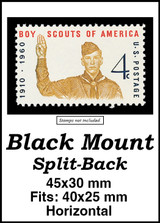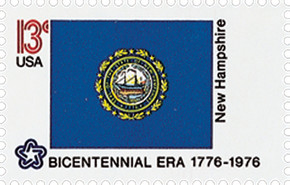
U.S. 1679
1976 New Mexico
State Flags
American Bicentennial Series
• First time a sheet 50 had all different stamp designs
• Part of the American Bicentennial Series
Stamp Category: Commemorative
Series: American Bicentennial Series
Value: 13¢ First-class postage rate
First Day of Issue: February 23, 1976
First Day City(s): Wa... more
U.S. 1679
1976 New Mexico
State Flags
American Bicentennial Series
• First time a sheet 50 had all different stamp designs
• Part of the American Bicentennial Series
Stamp Category: Commemorative
Series: American Bicentennial Series
Value: 13¢ First-class postage rate
First Day of Issue: February 23, 1976
First Day City(s): Washington, DC
Quantity Issued: 8,720,100 (panes of 50)
Printed by: Bureau of Engraving and Printing
Printing Method: Photogravure
Format: Sheet of 50
Perforations: 11
Why the stamp was issued:
The United States Postal Service celebrated the American Bicentennial with a full pane of the Union’s fifty state flags.
About the stamp design:
When New Mexico became a state in 1912, the first state flag was a blue field with a small U.S. flag in the top-left corner. The state seal was in the bottom-right corner, with “New Mexico” running from the top-left to bottom-right corners. But a better alternative was soon offered.
In 1920, the Daughters of the American Revolution suggested a design to better represent New Mexico’s unique heritage. They proposed using an ancient symbol for the sun found on a Zia Pueblo water jar in the late 19th century. The resulting flag has a circle that represents the unending cycles of love and life connecting the four points of the sun. The Spanish heritage in the region is acknowledged by using the traditional family colors of Queen Isabella of Spain – red for the design, set on a yellow background.
About the printing process:
Printed by the Bureau of Engraving and Printing on their seven-color Andreotti gravure press (601) which was their work horse for multicolored stamps.
About the American Bicentennial Series:
In the 1970s, America celebrated its 200th anniversary with hundreds of national events commemorating the heroes and historic events that led to our nation’s independence from Great Britain. The U.S. Postal Service issued 113 commemorative stamps over a six-year period in honor of the U.S. bicentennial, beginning with the American Revolution Bicentennial Commission Emblem stamp (U.S. #1432). As a group, the Bicentennial Series chronicles one of our nation’s most important chapters, and remembers the events and patriots who made the U.S. a world model for liberty.
Several of the stamps honored colonial life – craftsmen and communication. Other stamps honored important battles including Lexington and Concord, Bunker Hill, and Saratoga. Significant events such as the Boston Tea Party, the meeting of the First Continental Congress, and the Declaration of Independence were featured as well. The stamps also honored many significant people such as George Washington, Sybil Ludington, Salem Poor, and the Marquis de Lafayette.
Many of the stamps feature classic artwork. For instance, the set of four souvenir sheets picture important events recreated by noted artists such as John Trumbull. The Bicentennial Series also includes an important US postal first – the first 50-stamp se-tenant – featuring all 50 state flags. The format proved to be popular with collectors, and has been repeated many times since.
The American Bicentennial Series is packed with important US history – it tells the story of our nation’s fight for independence through stamps.
History the stamp represents:
On January 6, 1912, New Mexico was admitted to the Union.
Native Americans may have lived in New Mexico 20,000 years ago. Ancient spearheads found around Folsom and other sites indicate that Indians hunted there at least 10,000 years ago. The Mogollon Indians lived in the valleys near the New Mexico-Arizona border from about 500 B.C. to 1200 A.D.
The Anasazi Indians lived in the upper northwestern portion of New Mexico. These people had a remarkable civilization, raising corn and cotton and keeping domesticated turkeys. The Anasazi built large, apartment-style houses. One of these houses had between 600 and 700 rooms. The Pueblo Indians are the descendants of the Anasazi. The Navajo and Apache Indians came to the area around 1500 A.D. The Ute and Comanches settled there a short time later.
The first whites to reach New Mexico did so almost by accident. Álvar Núñez Cabeza de Vaca, a Spanish explorer looking for gold, was shipwrecked in Texas. Most of his crew drowned. After wandering for eight years, Cabeza de Vaca found a large Spanish settlement in what is now Mexico. The men shared stories about seven cities of phenomenal wealth, which they called the “Seven Cities of Cibola.” Cabeza de Vaca claimed the cities were located to the north. In 1539, Marcos de Niza, a priest guided by one of Cabeza de Vaca’s men, searched for the cities. Marcos de Niza claimed New Mexico for Spain during this expedition. Other explorers also searched the region for the Seven Cities of Cibola. Of course, none were successful. However, the explorations of Antonio de Espejo led to Spanish colonization of the area.
Spain established a colony in New Mexico in 1598. The colony was located at the Pueblo of San Juan de Los Caballeros, near the Chama River. Juan de Oñate, who became the governor of the province of New Mexico, financed it. Later, Pedro de Peralta became governor, and moved the capital to Santa Fe in 1609 or 1610. Today, Santa Fe is the oldest seat of power in the United States.
The colony was very poor and probably wouldn’t have survived if not for the efforts of Roman Catholic missionaries who wished to teach the Indians Christianity. There were many conflicts between the Spanish and Indians, and amongst the Spanish, between church and civilian authorities. The Spaniards imposed forced labor on the Indians in a system similar to slavery. Roman Catholic authorities forbade the Indians from worshiping their gods. In 1680, Popé led the Indians in a revolt against the Spanish. More than 400 Spanish were killed, and nearly every trace of the Roman Catholic Church was destroyed. In 1692, Diego de Varga retook the province with only minimal fighting. For the next 125 years, the Spanish and Indians lived together in relative peace.
Mexico won its independence from Spain in 1821. New Mexico became a Mexican province. Also in 1821, American William Becknell blazed the Santa Fe Trail. This trail allowed goods to be shipped from New Mexico to Missouri. Mexico ruled New Mexico for 25 conflict-ridden years. Mexicans and Indians rebelled against the government in 1837. The rebels killed the governor and seized the Palace of Governors in Santa Fe. José Gonzales, a Taos Indian, took control of the province. A month later, Mexican General Manuel Armijo crushed the rebellion and established himself as governor.
In 1841, a small force from the Republic of Texas, at that time an independent nation, invaded New Mexico. The Texans attempted to claim the land east of the Rio Grande but the Mexican army easily defeated them.
As American settlers moved westward, tensions increased between the U.S. and Mexico. In 1846, the Mexican–American War erupted. U.S. forces led by General Stephen W. Kearny easily captured New Mexico. The war ended in 1848, with the Treaty of Guadalupe Hidalgo. New Mexico was now U.S. property.
Congress created the territory of New Mexico in 1850. At that time the territory included today’s Arizona and parts of Colorado and Nevada. In 1853, the U.S. made the Gadsden Purchase from Mexico, acquiring land south of the Gila River. This land was added to the territory. In 1863, Congress created the Colorado and Arizona territories, and New Mexico received its present boundaries.
During the Civil War, Confederates from Texas took the territory of New Mexico. In March 1862, Union forces regained control. From 1862-64, a group of New Mexico settlers, led by famous frontier scout Kit Carson, fought to force the Mescalero Apache and Navajo Indians to live on reservations. During the late 1870s, the so-called Lincoln County War erupted. This conflict was waged for political control of this lucrative cattle country. The famous outlaw Billy the Kid, among others, took part in the fighting. In 1878, General Lew Wallace was appointed governor of the territory. To end the bloodshed, he granted a pardon to all the participants in the fighting. However, in 1881, Lincoln County sheriff Pat Garrett killed Billy the Kid. The Apache chief Victorio led attacks against New Mexico settlers from 1879 to 1880, when he died. One of the last hostile Apache leaders, Geronimo, wreaked havoc in the area until he surrendered on September 4, 1886.
New Mexico achieved statehood on January 6, 1912. At that time, the state had a population of about 330,000 people. Just a few years later Mexican rebels, perhaps led by the legendary Pancho Villa, attacked the town of Columbus and killed 17 people. The U.S. Army sent a force into Mexico to catch Villa, but they were unsuccessful.
Less
Most Orders Ship
within 1 Business Day
90 Day Return Policy
Satisfaction Guaranteed
Earn Reward Points
for FREE Stamps & More












